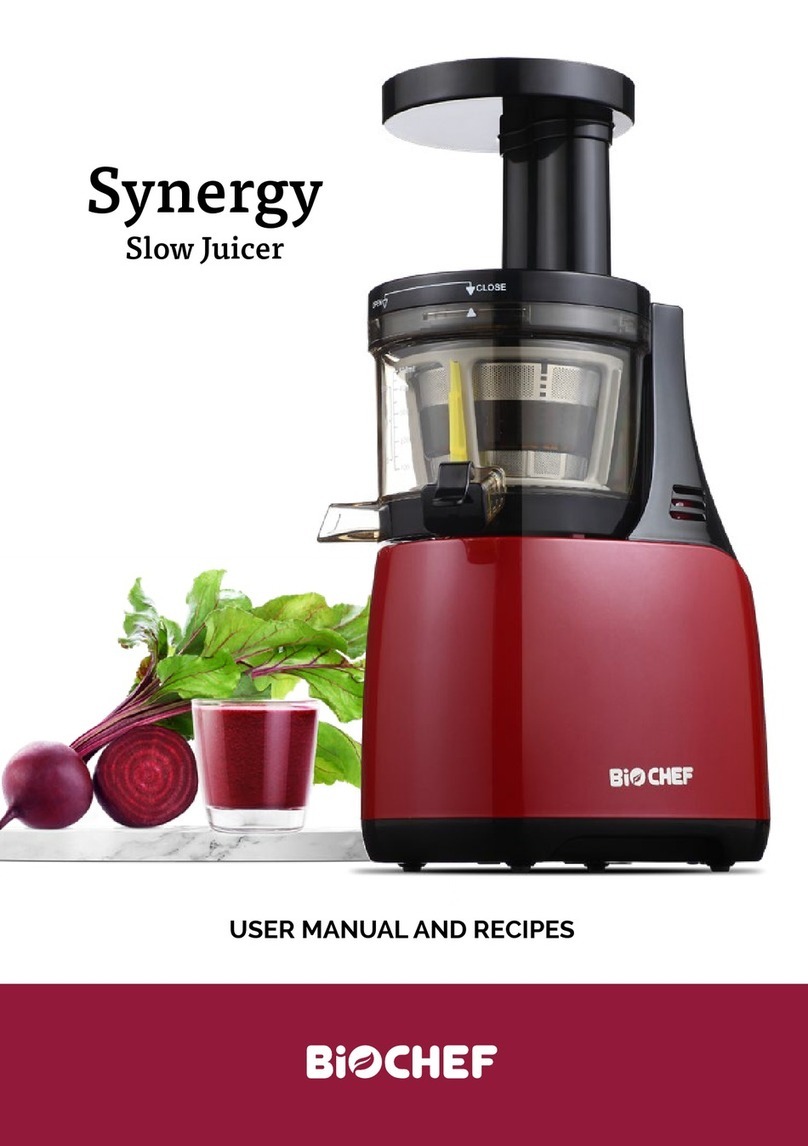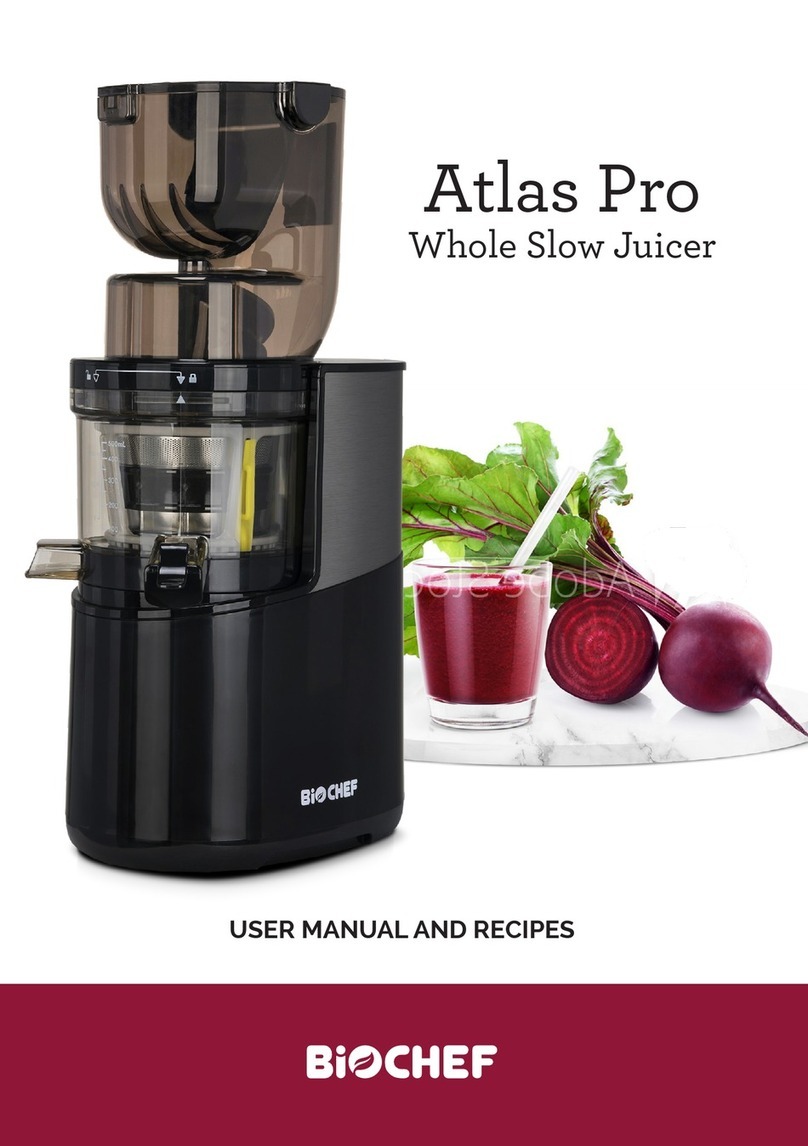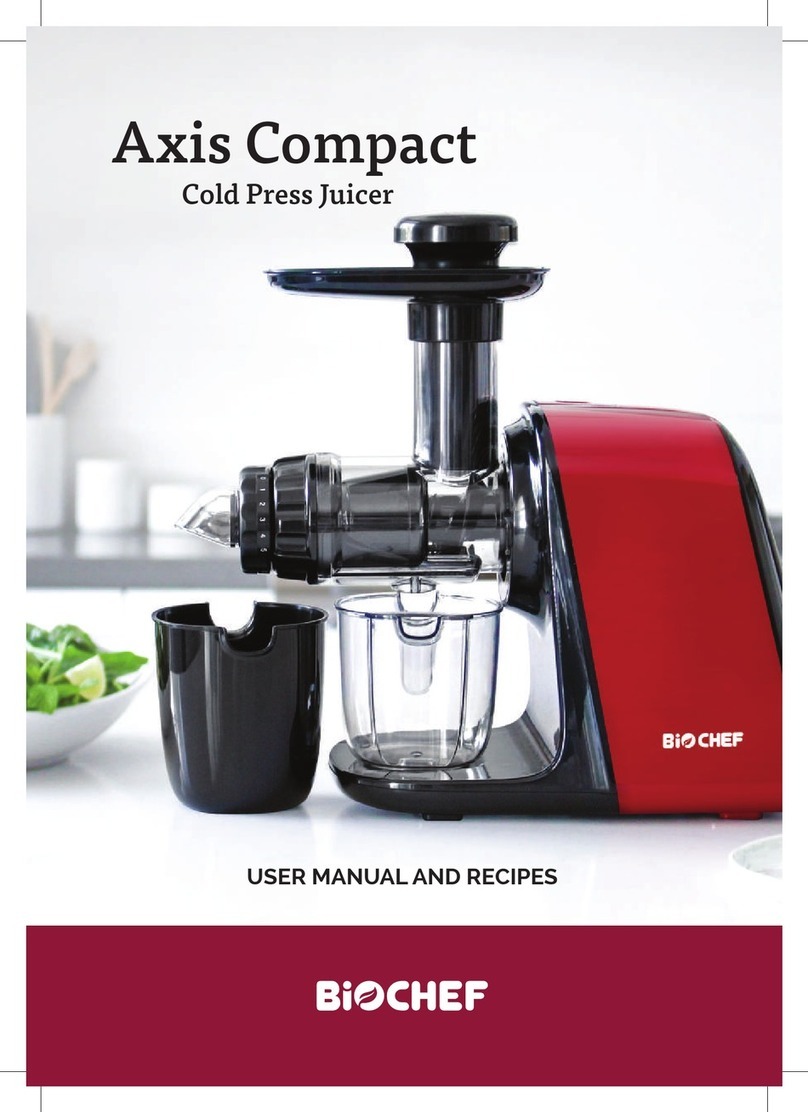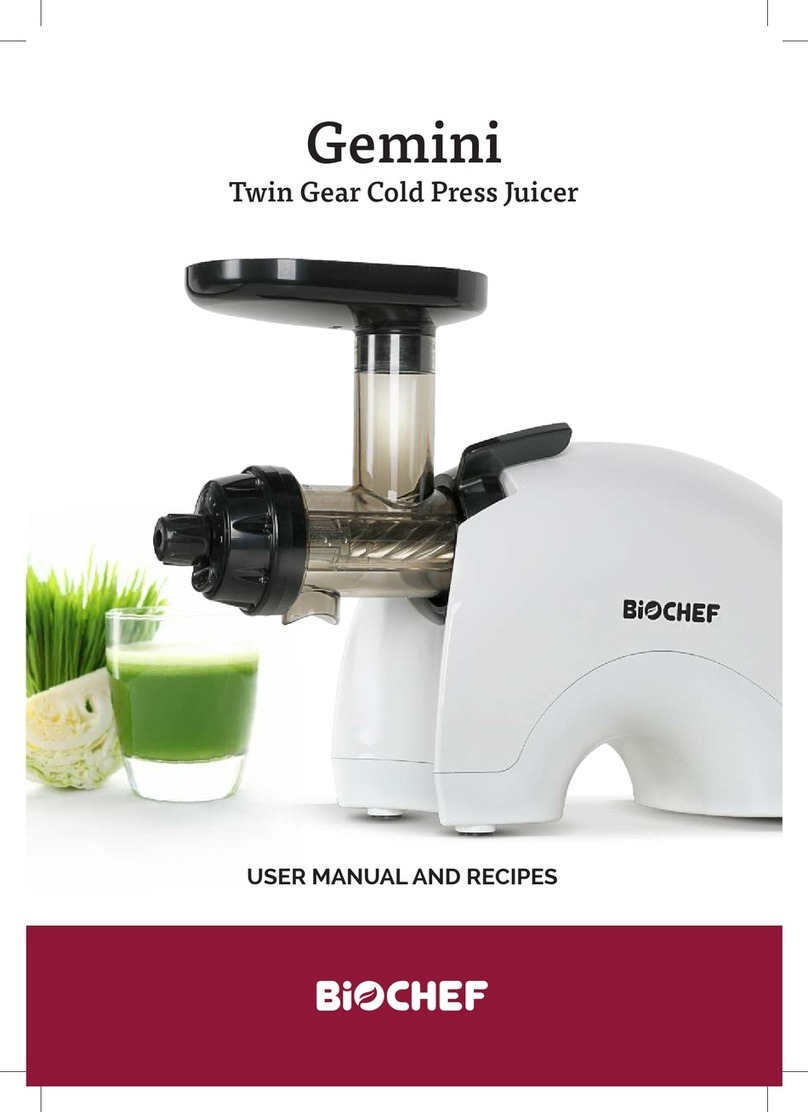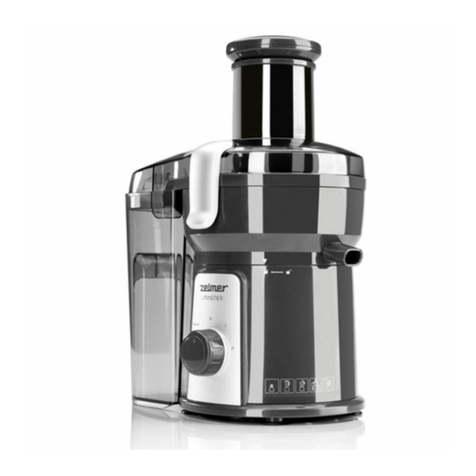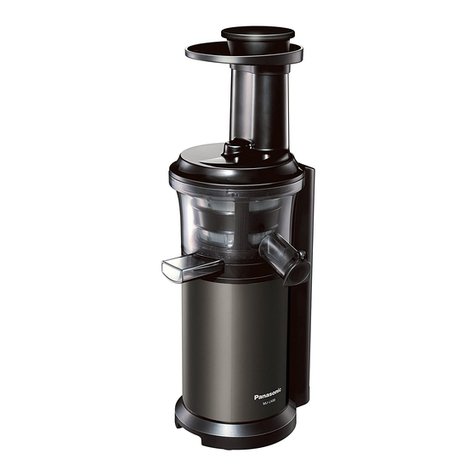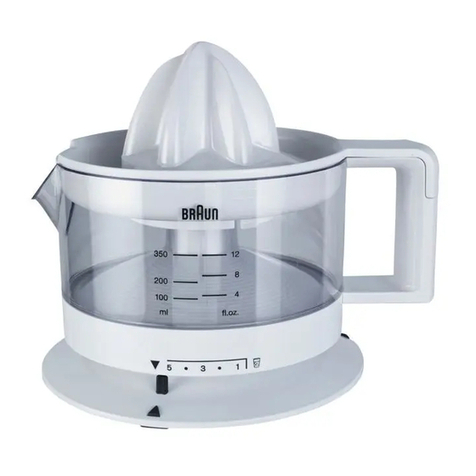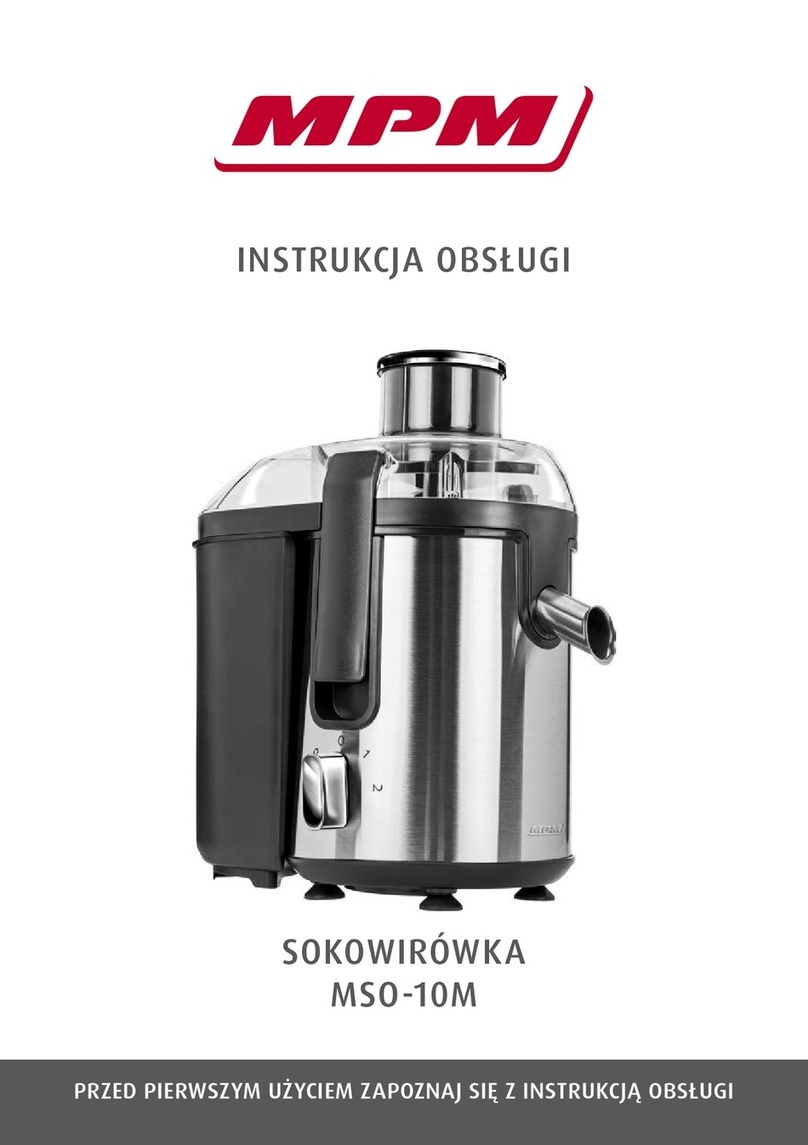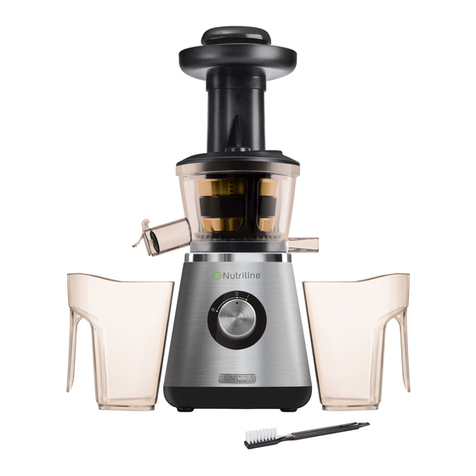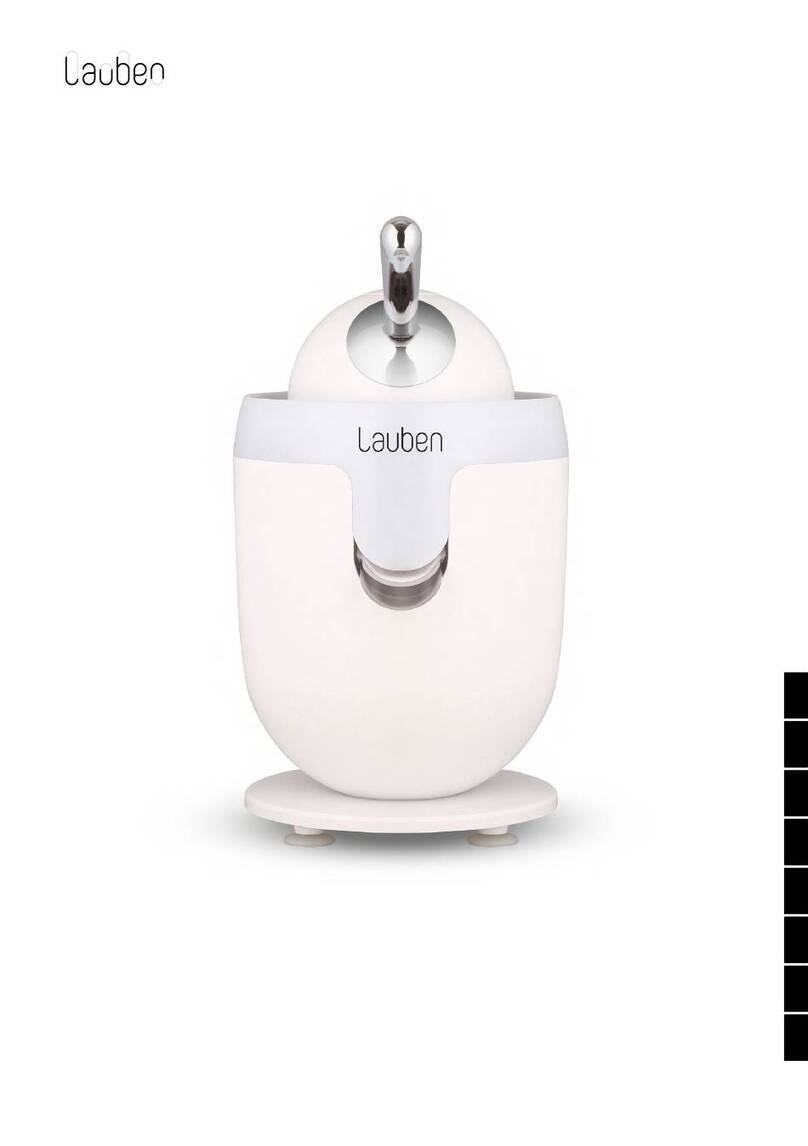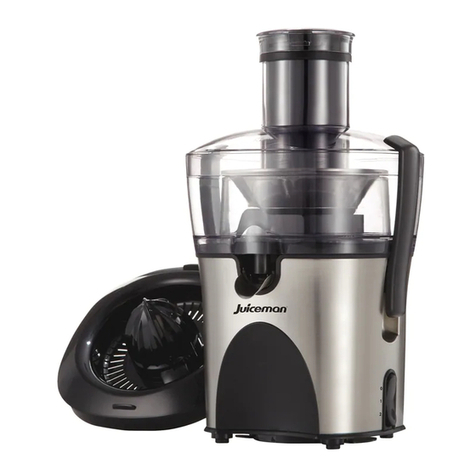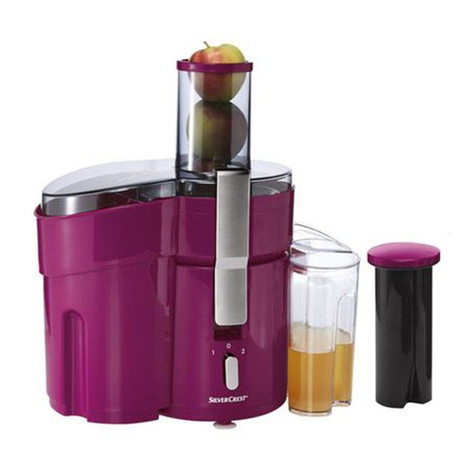Biochef Axis Technical specifications

Axis
Cold Press Juicer
USER MANUAL AND RECIPES

ENGLISH 3
EN
FRANÇAIS 25
FR
DEUTSCH 51
DE
ESPAÑOL 77
ES
The information in this manual is intended to help
you to get the best results from your BioChef Axis
Cold Press Juicer. Please read and follow these
instructions and safeguards prior to use.
Please keep your manual handy for future
reference, warranty information and support details

4
Safety Precautions
! Read all instructions.
! To protect against risk of electrical shock, do not put the body (motor) in
any water or other liquid .
! Close supervision is necessary when any appliance is used by children.
! Unplug from electrical outlet when not in use and before disassembly
for cleaning.
! Avoid contact with moving parts.
! Do not operate appliance with a damaged cord or plug.
! The use of attachments not recommended or sold by the manufacturer
may cause damage and will void warranty.
! Do not let cord hang over edge of counter.
! Always make sure juicer locking clip is closed while juicer is in operation.
! Make sure the motor has stopped completely before disassembling.
! Do not put your ngers or other objects into the juicer while it is in
operation. If food becomes lodged in the opening, use the provided
food plunger to push it down or press the button into reverse mode. If
ingredients are still lodged in the juicing drum, turn o and disassemble
to remove remaining food. You may need to cut produce smaller, or feed
ingredients slower into the chute to prevent this.
EN

5
Parts and Accessories
1 Hopper and Feeding Chute
2 Drum
3 Drum Cap
4 Auger
5 Motor Base
6 Nozzles
7 2 x Juicing Strainers
8 Mincing Strainer
9 Tamper
10 Juice Container
11 Pulp Container
12 Cleaning Brush
1
25
4
3
6
7
8
9
10
12
11
EN

6
Connect drum with
motor base by turning
locking clip clockwise.
Place hopper into guide.
Assembly Instructions
Switch the juicer o before changing accessories or touching any moving
parts. Remove the drum from the main body by turning the locking clip
counter clockwise. Pull the auger forward to disassemble it from the drum set.
! DO NOT place any metal objects into the hopper. If the drum is clogged or
the machine stops operating, press the reverse button 2 to 3 times and
press the ON button again to resume normal operation.
! DO NOT immerse the motor in water.
EN

7
FOR JUICING
1. Place the auger into the drum.
2. Insert the juicing strainer (over
the auger) and into the drum.
3. Place the drum cap onto the
drum end and turn it counter
clockwise until seated rmly.
4. Attach the Pulp Ejection Cover to
the drum end cap.
NOTE: The pulp ejection cover is
numbered from 0 - 5, with 5 being
the ‘rmest’ position. For harder and
brous produce, such as carrots and
celery, set the position to high (i.e. 4 or
5), and for softer, pulpier produce, turn
the knob to 1 or 2.
FOR MINCING, PASTA, NOODLES AND BREAD
1. Open the drum cap.
2. Insert the mincing strainer (over
the auger) into the drum.
3. Attach the desired nozzle onto
the drum cap.
4. Turn the drum cap counter
clockwise until seated rmly.
FOR PASTA & NOODLES: Sprinkle a small
amount of our on a collection tray
and cut pasta / noodle lengths with
scissors as it is extruded.
EN

8
Operating Instructions
• While the Axis Cold Press Juicer / Food Processor can extract juice from
unpeeled fruits and vegetables we recommend you thoroughly wash and
peel your fresh ingredients to remove any chemicals.
• Cut fruit or vegetables into small pieces (5cm wide) so that juice may be
extracted thoroughly.
• Turn on the machine before placing ingredients into the hopper one piece
at a time and gently push through with the tamper.
• For maximum eciency, the drum cap should be rmly screwed on (position
5) for hard, brous ingredients such as carrots and beetroot and wound out
for softer ingredients such as citrus. The quality of produce will also aect
juice yield.
• After placing the last pieces of fruits or vegetables into the hopper, keep
the machine running for a few seconds longer to ensure the machine has
extracted the last drops of juice.
• DO NOT run the machine for more than 30 minutes at a time.
EN

9
Troubleshooting
The motor
sounds noisy,
what shall I
do?
1. If the juicer starts to vibrate slightly during
operation, turn o the machine and empty the drum
set. Re-assemble and resume normal operation.
2. If your machine is making a loud noise, take all the
extra parts o the machine and run the motor alone.
If it is still making a loud noise then contact your
distributor.
3. If the motor is not making a noise, check that all
parts and seals are clean, as residue may create a
noise.
4. Check the kind of produce you are using, as
some kinds of produce are noisier than others, for
instance, if your produce is particularly hard or has
been frozen or refrigerated.
What shall I
do if I’ve lost
the original
tamper?
Call your distributor and order a new part. It is very
important to use the correct plunger/tamper for the
machine as they are made to t each juicer precisely.
PLEASE NOTE Using any other type of plunger / pusher
or tamper will void warranty as the length and width of
the BioChef tamper is specic to this machine.
My juice is too
pulpy?
1. Adjut the pulp adjustment nozzle to number 4 or 5.
2. Introduce ingredients at a slower pace. Overfeeding
the juicer can result in pulpier juicer.
3. Ensure that your ingredients are fresh. Older
vegetables have less water content and can
produce a pulpier juice.
EN

10
I would like
more pulp in
my juice.
Adjust the pulp adjustment nozzle closer to number 1
or 2.
Produce is
clogged in my
juicer, how
can I avoid
this?
1. Softer fruits can cause the machine to clog. Always
alternate soft and hard produce for maximum juice
yield.
2. Introduce ingredients at a slower pace.
3. Adjust pulp nozzle to 1-2.
PLEASE NOTE If your juicer becomes clogged, switch into
reverse mode for a couple of seconds, switch o juicer
and disassemble the machine.
EN

11
FAQs
Do I need to refrigerate fruits and
vegetables before juicing them?
Apart from tasting better when
juiced, refrigerated fruits and
vegetables will provide a higher
yield of juice than room temperature
produce. This is because the bre
in refrigerated produce is rmer
when chilled and consequently
provides more juice when crushed
compared to softer or warmer fruits
and vegetables, which may also be in
a partial stage of dehydration (losing
water content).
What’s the best way to prepare
fruits, vegetables and leafy greens
for juicing in the BioChef juicer?
VEGETABLES
We recommend preparing your
vegetables by cutting them into
pieces that will simply fall through
the feeding chute without assistance.
FRUITS
We recommend preparing your fruits
by cutting them into pieces that will
simply fall through the feeding chute
without assistance. We recommend
removing skins from most citrus
fruits although one third of the skin of
lemons and limes may be left on.
LEAFY GREENS
Roll leaves into parcels and then fold
them in half, ensuring that the parcels
will simply fall through the feeding
chute without assistance. You may
notice with some leafy greens that
they can cause the BioChef juicer to
clog. This can be remedied by adding
a few pieces of carrot or other brous
vegetables, which will help to push
through the leafy green material.
Also, wet leaves will not pass through
the juicer as well as drier leaves, so
when washing produce, pat dry with a
kitchen towel before inserting into the
BioChef juicer. The horizontal crushing
and squeezing mechanism of the juicer
means that the smaller you cut the
pieces before you feed them into the
shoot, the less likely that the bres will
become tangled around the internal
mechanism. For best results cut your
ingredients into 3 - 5cm pieces.
WHEATGRASS
Cut the grass close to the roots
and wash thoroughly to ensure no
soil or stones are present. Feed the
wheatgrass tips rst into the juicer.
When juicing wheatgrass, place a
bunch of wheatgrass (about 3cm
diameter) ‘tips down’ into the feeding
chute.
What are the best apples for juicing?
We nd that fresh and chilled green
apples are the best. Nutritionally,
green apples contain various
antioxidants, are a good source of
vitamin C and are considered to be
able to prevent the formation of
gall stones in the bladder and help
remedy liver and kidney disorders.
EN

12
Do I need to peel citrus for juicing?
We recommend peeling the skin
from mandarins, oranges and
grapefruit prior to juicing as the skin
has a bitter taste and this will transfer
through to the juice. The skin of
lemons and limes do not have this
bitter avour and as such can be
juiced. Leave about one third of the
skin of lemons and limes on.
What can I juice with a BioChef
juicer and what should I avoid?
The BioChef juicer can juice
just about all types of fruits and
vegetables.
This is a cold press juicer and
therefore does not have a cutting
unit, so do not place any of the
following in the juicer as it may cause
damage:
• hard coconut bre – soft, young
esh is ok
• seeds (except sesame, or other
softer seeds)
• unsoaked/roasted nuts (except
peanuts and other softer nuts)
• legumes
• sugar cane
• frozen ingredients - for sorbet
remove fruit from freezer 5-10
minutes before using.
• sh or meat
• liquorice root or other woody
materials
• dried herbs and spices
• stone fruit with stones in
• olives
Can I make soy, nut and rice milk?
Yes you can easily make nut milk
using your juicer, simply refer to the
Recipes section for instructions.
Can I grind seeds, grains or legumes
with the BioChef juicer?
The BioChef juicer can make a paste
from seeds and grains, however is
not a grinder and using this machine
as such will void the warranty.
Can the BioChef juicer make cold
press olive oil?
No. This is a dierent process
to juicing and requires dierent
machinery.
Can I make frozen sorbets?
Yes you can easily make frozen fruit
sorbets using your juicer. Refer to the
recipes section for instructions.
Can I re-juice the discarded pulp in
order to get more juice?
The BioChef juicer is very eective
at extracting high yields but some
users may put through the discarded
pulp again to try and gain more
juice yield. The results vary from
dierent ingredients so feel free to
experiment. Try mixing the pulp with
blended fruits to make fruit roll ups.
We recommend a BioChef food
dehydrator for this.
EN

13
Is the BioChef juicer suitable for
commercial environments?
We recommend the juicer does
not run for more than 30 minutes
at a time. Therefore, if using in a
commercial environment we would
advise operating two or three juicers
intermittently.
PLEASE NOTE: The BioChef juicer
does not have a commercial
warranty and so use of the machine
in a commercial setting is at the
discretion of the owner. You could
also make a larger quantity of a
base juice such as carrot or orange
and then add specic ingredients as
listed on your menu.
How long can I keep the juice
before the nutritonal integrity has
depleted?
There’s no specic answer to this
as there are too many variables
based on the type of produce and
storage method. When storing juice,
refrigerate in a glass airtight jar or
bottle for best results. This storage
method will usually help retain the
nutritional integrity of your juice for
up to 48 hours.
Can I buy spare parts for my juicer?
Yes, simply contact your local service
provider (details located in rear
of manual) or order online on our
website.
EN

14
View our complete recipe collection online
www.biochefkitchen.com/recipes
Cleaning
The BioChef Axis parts are dishwasher-safe (top shelf). For best results, rinse
prior to placing into the dishwasher to remove any stubborn bres.
You can rinse your juicer easily after use by running water through the juicer.
If hand-washing simply rinse under water, and use the included cleaning
brush to scrub any tough bres. If you are in a hurry, simply leave the parts
soaking in water so the bres remain soft and pliable.
We recommend soaking your parts in a solution of bi-carb soda, water and
white vinegar or lemon juice once per month or on occasion. This does a great
job of removing any juice stains or residue that may build up over time.
EN

16
JUICES
Green Juice
Servings: 4
• 1 small bunch curly kale roughly
chopped
• 1 lemon peeled and quartered
• 1 inch ginger peeled
• 1 cucumber cut into long strips
• 2 granny smith apples cored and
sliced
• 4 celery stalks
Green juices are rich in chlorophyll
in its natural state – the way nature
intended.
One of chlorophyll’s most important
functions is the oxygenation of the
bloodstream. It is necessary for
health to select foods that feed
rather than rob the body of oxygen.
Without sucient oxygen in the
blood, we are prone to develop
symptoms of low energy, sluggish
digestion and metabolism, leading
to deterioration in vitality and an
increase in the onset of disease.
The addition of limes and apples to
green juices greatly assist to make
juices more tolerable to the palate.
Ginger
Zinger
Servings: 3
• 2 medium apples
• 5 carrots
• ½ inch fresh ginger
• ¼ lemon (peel removed to avoid
bitterness)
Pineapple
Pick-Me-Up
Servings: 4
• 3 medium carrots
• ½ small, ripened pineapple
(peeled, cored, and cut in quarters)
• 1 orange (peel removed)
EN

17
JUICES
Immune
Booster
Servings: 1 cup
• 1-3 cloves of garlic
• 1 inch fresh ginger
• 1 bunch of rainbow carrots (can
substitute for any carrots), tops
removed
This healing juice is a great remedy
for that cold that just won’t go
away. Carrots are a good source
of vitamin C, vitamin B complex,
potassium, iron and sodium which all
work to boost the immune system
and improve liver function. Raw
garlic is a natural anti-microbial anti-
inammatory and powerful tool for
boosting the immune system.
Mocktail
Mojito
Servings: 3
• 1 small bunch mint
• 1 small bunch parsley
• 1 lime (peel removed)
• ½ inch fresh ginger
• 2 cucumbers
• 1 green apple
Savoury
Gazpacho
Servings: 1 - 2
• 4 ripened plum tomatoes
• 1 large cucumber
• 2 stalks celery
• 1 red bell pepper
• ¼ small red onion
• 2 cups fresh parsley (leaves and
stems roughly chopped and
packed)
• 1 lime (peel removed)
Tomatoes are a great alkaliser
when consumed without sugars or
starches. Beetroot is a great blood
builder. Celery improves digestion.
Red Capsicum is good for skin, hair
and nails. Cucumber is a natural
diuretic. Parsley is high in minerals
including potassium.
EN

18
JUICES
Wheatgrass... nature’s healer
Wheatgrass is baby wheat, planted
on the soil and not sown. Wheatgrass
produces high concentrations of
chlorophyll, active enzymes, vitamins
and other nutrients. Chlorophyll
makes up over 70% of the solid
content of wheatgrass juice and
is the basis of all plant life. It is
often referred to as the “blood of
plant life” as it closely resembles
the molecule in human red blood
cells. Wheatgrass is not only rich
in chlorophyll; it has 100 elements
needed by the body to keep vital and
nourished. If grown in organic soil,
wheatgrass absorbs 92 of the known
102 minerals from the soil.
Dr. Ann Wigmore was a pioneer
in the use of wheatgrass juice for
detoxifying and healing the body,
mind, and spirit. The recommended
daily allowance for wheatgrass is 30
mls once or twice per day. You can
start with as little as 10–15mls per
day and gradually increase the dose.
Wheatgrass juice can temporarily
cause an upset stomach if too much
is consumed too soon.
Care and Use
Cut the grass close to the roots and
wash thoroughly to ensure no soil
or stones are present. You can get a
second yield when the grass grows
back, although the content won’t be
as rich as the original grass. Feed
the wheatgrass tips rst into the Axis.
Four trays planted on dierent days
over a two week period should be
enough for 1 person. Undoubtedly,
wheatgrass has a very strong taste.
You can mix the wheatgrass shots
and here are a couple of delicious
recipes.
When juicing wheatgrass, barley
grass or alfalfa juice, place a bunch
of wheatgrass (about 3cm diameter)
‘tips down’ into the feeding chute.
Feed carrots and other desired fruits
or vegetables into the chute for a
milder tasting combination for those
who haven’t tried pure wheatgrass
juice before.
EN

19
SOUPS & DIPS
Juiced Tomato
& Herb Soup
• 8 tomatoes
• 2 carrots
• pinch of salt
• pinch of black pepper
• 1 tsp dill
• 2-3 basil leaves
• 1 tsp olive oil
Using the juicing strainer, feed in the
carrots and tomatoes then mix all the
ingredients together.
For more bre, let everything run
through again with the mincing strainer
this time, adding some of the pulp.
Decorate with a sprinkle of fresh
herbs or owers.
Pesto
• 1 ½ cups basil leaves
• bunch of parsley
• 1 garlic clove
• 1 cup pine nuts (or pistachio)
• juice of ½ lemon
• 2 tsp olive oil
Using the mincing strainer feed the
basil, parsley, garlic and pine nuts
into the chute. Mix the oil and lemon
juice into the paste until smooth.
Max Salsa
• 4 ripe tomatoes
• ½ red or green capsicum
• ½ stick celery
• 1 small onion
• 1 garlic clove
• 1-2 tbsp fresh coriander
• ½ tsp cumin
• Braggs liquid aminos
• cayenne pepper or fresh chilli
Using the mincing strainer, feed
all the ingredients into chute
alternatively. Mix well and serve
vegetable with sticks or crackers.
Beetroot
Hummus
• 1 ½ cups cooked chickpeas
• ½ beetroot peeled and chopped
• ¼ tsp. salt
• 1-2 garlic cloves, peeled
• 2 tbsp. hulled tahini
• 1-2 tbsp. olive oil
• Squeeze of fresh lemon juice
Using the mincing strainer feed
chickpeas, beetroot and garlic into
the chute.
Thoroughly mix all remaining
ingredients together and serve.
EN

20
NUT BUTTERS
Peanut Butter
• 2 cups roasted unsalted peanuts
• olive oil
• vitamin c powder (sodium
ascorbate)
Using the mincing strainer slowly
add the peanuts while machine is
running. Stop the machine and add
the Vitamin C powder and enough
olive oil to the peanut paste to make
a nice soft spreading consistency.
—
Fresh nut butters are an ideal spread
for sandwiches, base for satay,
dressings or as part of a delicious
dip. Almost any variety of nuts can
produce nut butter. Some varieties of
nuts don’t have high oil content so if
you want a creamy butter, add nut or
olive oil until you reach the desired
consistency.
Another hint for a creamy butter
is to pour in the nuts slowly and
alternatively, for crunchy nut paste
pour in the nuts faster. Relatively
soft nuts such as peanuts, pine nuts,
macadamias and cashews may be
poured in without soaking, while
harder nuts must be soaked for
around 8 hours.
When nuts are soaked, the nuts
become ‘activated’ and the enzyme
inhibitors are rinsed away and they
are easier to digest.
TREATS
Bliss Balls
• 2 cups almonds soaked, rinsed
and drained
• 1 cup unsulphured dried fruits
such as dates, raisins and apricots*
• ½ cup dessicated coconut
Using the mincing strainer, mince
almonds, alternating with the dried
fruit. Form into balls and roll in
coconut. For variation, use dierent
nuts, carob powder, natural vanilla
essence or peppermint oil.
Peanut Balls
• 2 cups peanuts
• 1 cup sesame seeds
• 4 apricots
• 2 tbsp honey
• juice of half an orange
Mix peanuts, apricots, honey, juice
and 1 cup sesame seeds in bowl.
Using the mincing strainer, feed
through the chute. Roll paste into
balls and into remaining sesame
seeds.
EN
Table of contents
Other Biochef Juicer manuals


